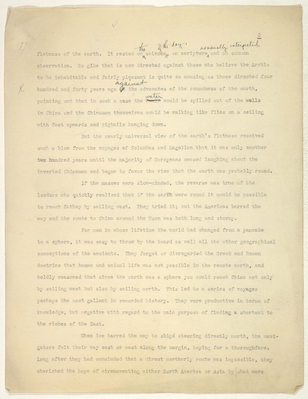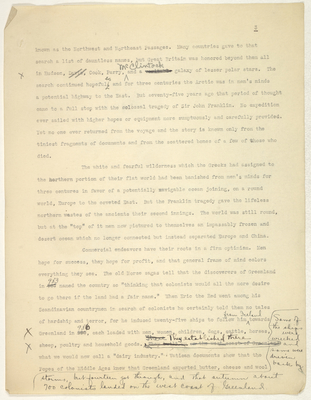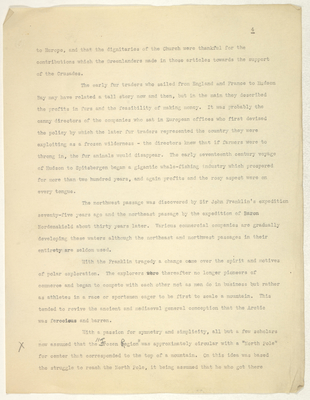Pages
stefansson-wrangel-09-26-001-006
flatness of the earth. It rested on the scienceof the day, on scripture as usually interpreted, and on common observation. No gibe that is now directed against those who believe the Arctic to be inhabitable and fairly pleasant is quite so amusing as those directed for hundred and forty years ago against the advocates of the roundness of the earth, pointing out that in such a case the wouldwater would be spilled out of the wells in Chine and the Chinamen themselves would be walking like flies on a ceiling with feet upwards and pigtails hanging fown.
But the nearly universal view of the earth's flatness received such a blow from the voyages of Columbus and Magellan that it was only another two hundred years until the majority of Europeans ceased laughing about the inverted Chinamen and began to favor the view that the earth was probably round.
If the masses were slow-minded, the reverse was trye of the leaders who quickly realized that if the earth were round it would be possible to reach Cathay by sailing west. They tried it; but the Americas barred the way and the route to China around the Horn was both long and stormy.
For men in whose lifetime the world had changed from a pancake to a sphere, it was easy to throw by the board as well all the other geographical conceptions of the ancients. They forgot or disregarded the Greek and Roman doctrine that human and animal life was not possible in the remote north, and boldly reasoned that since the earth was a sphere you could reach China not only by sailing west but also by sailing north. This led to a series of voyages perhaps the most gallant in recorded history. They were productive in terms of knowledge, but negative with regard to the main purpose of finding a shortcut to the riches of the East.
When ice barred the way to ships steering directly north, the navigators felt their way east or west along the margin, hoping for a thoroughfare. Long after they had concluded that a direct northerly route was impossible, they cherised the hope of circumeventing either North America or Asia by what were
stefansson-wrangel-09-26-001-007
3
known as the Northwest and Northeast passages. Many countries gave to that search a list of dauntless names, but Great Britain was honored beyond them all in Hudson, Davis, Cook, Parry, McClintockand a galaxy of lesser polar stars. The search continued gopefully and for three centuries the Arctic was in men's minds a potential highway to the East. But seventy-five years ago that period of thought came to a full stop with the colossal tragedy of Sir John Franklin. No expedition ever sailed with higher hopes or equipment more sumptuously and carefully provided. Yet no one ever returned from the voyage and the story is known only from the tiniest fragments of documents and from the scattered bones of a few of those who died.
The white and fearful wilderness which the Greeks had assigned to the northern portion of their flat world had been banished from men's minds for three centures in favor of a potentially navigable ocean joining, on a round world, Europe to the coveted East. But the Franklin tragedy gave the lifeless northern wastes of the ancients their second innings. The world ’was still round, but at the "top" of it men now pictured to themselves an impassably frozen and desert ocean which no longer connected but instead separated Europe and China.
Commercial endeavors have their roots in a firm optimism. Men hope for success, they hope for profit, and that general frame of mind colors everything they see. The old Norse sagas tell that the discoverers of Greenland in 987983named the country so "thinking that colonists would all the more desire to go there if the land had a fair name." Then Eric the Hed went among his Scandinavian countrymen in search of colonists he certainly told them no tales of hardship and terror, for he induced twenty-five ships to follow him from Icelandtowards Greenland in 986, each loaded with men, women, children, dogs, cattle, horses, sheep, poultry and household goods. They established there what we would now call a "dairy industry." Vatican documents show that the Popes of the Middle Ages knew that Greenland exported butter, cheese and wool some of the ships were wrecked and some were driven back by storms, but fourteen got throuhg and that autumn about 700 colonists landed on the west coast of Greenland.
stefansson-wrangel-09-26-001-008
4
to Europe, and that the dignitaries of the Church were thankful for the contributions which the Greenlanders made in those articles towards the support of the Crusades.
The early fur traders who sailed from England and France to Hudson Bay may have related a tall story now and then, but in the main they described the profits in furs and the feasibility of making money. It was probably the canny directors of the companies who sat in European offices who first devised the policy by which the later fur traders represented the country they were exploiting as a frozen wilderness - the directors knew that if farmers were to throng in, the fur animals would disappear. The early seventeenth century voyage of Hudson to Spitsbergen began a gigantic whale-fishing industry which prospered for more than two hundred years, and again profits and the rosy aspect were on every tongue.
The northwest passage was discovered by Sir John Franklin’s expedition seventy-five years ago and the northeast passage by the expedition of Baron Nordenskiold about thirty years later. Various commercial companies are gradually developing these waters although the northeast and northwest passages in their entirety are seldom used.
With the Franklin tragedy a change came over the spirit and motives of polar exploration. The explorers were thereafter no longer pioneers of commerce and began to compete with each other not as men do in business but rather as athletes in a race or sportsmen eager to be first to scale a mountain. This tended to revive the ancient and mediaeval general conception that the Arctic was ferocious and barren.
With a passion for symmetry and simplicity, all but a few scholars now assumed that the "Frozen Region" was approximately circular with a "North Pole" for center that corresponded to the top of a mountain. On this idea was based the struggle to reach the North Pole, it being assumed that he who got there
stefansson-wrangel-09-26-001-009
5
first would correspond (on a far greater scale) to the man who first climbed Mont Blanc. We have evidence of this, not only in the firm general idea which still holds, but also in the definite utterances of those who were engaged in the race. Especially is this clear in the titles of their books, as Nansen's "Farthest North", Peary's "Nearest the Pole."
Both the participants in the game of Arctic explorations and the spectators who watched it through newspapers and books knew about the Gulf Stream and the warm north Atlantic drift. They knew that these and other influences make Reykjavik, Iceland, a little as warmer on the average in January than as Milan, X Italy and that Christmas night on the north coast of Norway, eight hundred miles north X of Scotland, is warmer on the average than at Minneapolis which is farther south than the middle of France. They knew, but did not realize, that these and similar causes prevented the possibility that the North Pole could be anywhere near the center of whatever icy area there might be in the Arctic. They had the data for calculating (if it had occured to them to do so) that the North Pole is about four hundred miles from the center of the floating ice that troubles Arctic navigators.
In recent years many have come to realize that the struggle to X attain the North Pole was based on a misapprehension. since the pole The North Pole cannot correspond in difficulty to the top of a mountain, for it is nowhere near the center of the inaccessible area (which center is called the Pole of Inaccessibility and lies near 84° N. Latitude and 160° W. Longitude, about four hundred miles away from the North Pole in the direction towards Alaska). But that is by no means the most important misconception we are rid of. We have come to realize that on the lowlands in the Arctic, both in North America and Asia, midX summer temperatures are sometimes as high as at the south tip of Florida (plus 85° F. to plus 95° F. in the shade and even hotter). We know that the snowfall in the Arctic averages less than in Scotland and that all the snow of winter disappears in summer from every arctic land except those that are mountainous -
stefansson-wrangel-09-26-001-010
6
and most of the arctic lands are low. We know there are many hundreds species of flowering plants in the region formerly supposed to be covered by eternal ice and that there is more eternal ice in Mexico than there is in an equal area of arctic and subarctic continental Canada. We know that bees and butterflies go about among the midsummer flowers on the northe coasts of the most northerly lands in the world.
But we might have in our minds all this and more of the new knowledge about the Arctic and still the realization of the hopes of the Middle Ages about a short route to the Far East might be as remote as ever. The climate is not eternally cold, for the summers are warm; the lands are not eternally ice-covered, for few of them are mountainous; the sea is not covered with one vast expanse X of ice, for the ice is not strong enough to standl the strain of even moderate []wind, and is broken, X over in mid-winter and summer alike, into millions of floes of varying sizes drifting about and jostling each other, with large patches of open water between them. All these things are true and still it remains equally true that for ordinary ships the Arctic is not a navigable ocean on the direct route from Europe to the Pacific.
But there lies above the partly ice-filled water the wide unjhampered ocean of the air, free to be navigated in every direction by ships of the air.
The most optimistic students consider that flying conditions over the Arctic throughout the year are on the average better than over the north Atlantic. The most pessimistic consider them probably worse, but conquerable. Those who hold a middle ground think that the Arctic is perhaps more favorable than the Atlantic in summer but that it would be less favorable in winter.. Some of the highest authorities have said that January flying across the Arctic will probably turn out to be not only easier than north Atlantic flying in January but actually easier than arctic flying in July. The authorities differ partly because some think only of our flying technique as it is to-day. But there is likely to be as much progress in aviation during the next five years as there has been during the past five, and many of the difficulties of to-day will be conquered




